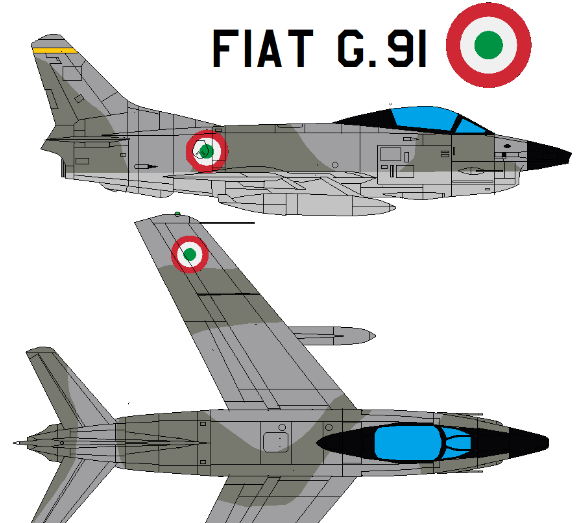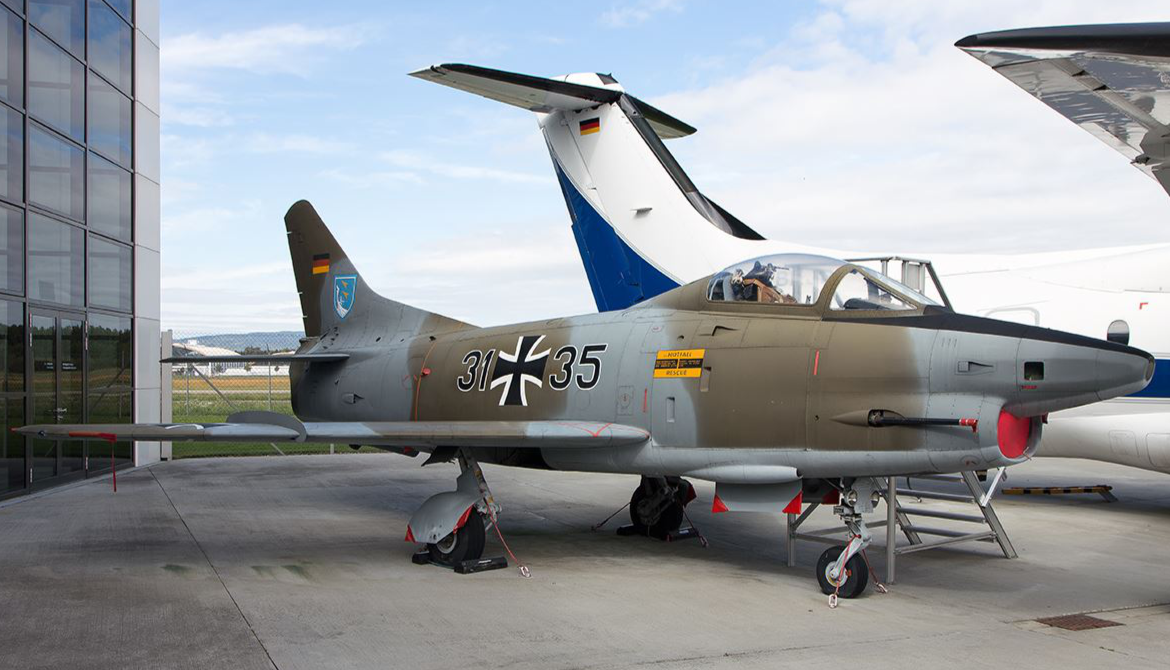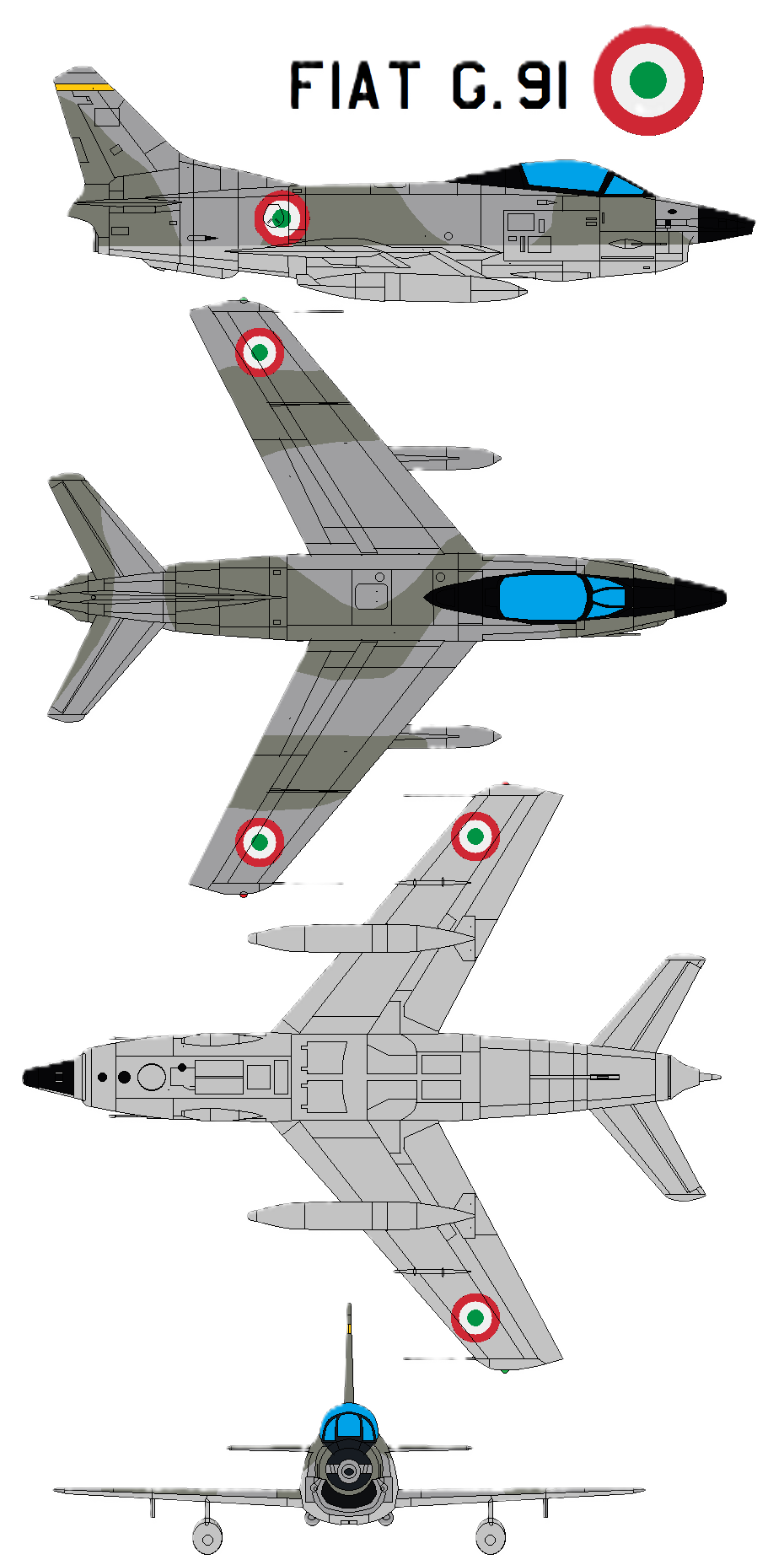Fiat Aviazione Fiat G.91 Fighter-bomber
 |
|
| General information | |
|---|---|
| Type | Fighter-bomber |
| Manufacturer | Fiat Aviazione / Aeritalia |
| Status | Retired |
| Primary users | Italian Air ForceGerman Air Force Portuguese Air Force |
| Number built | 770 |
| History | |
| Manufactured | 1956–1977 |
| Introduction date | 1958 |
| First flight | 9 August 1956 |
| Retired | 1995 |
| Variants | Fiat G.91Y |
.
History Fiat Aviazione / Aeritalia
Fiat G.91 Fighter-bomber "Gina"

The Fiat G.91 is a jet fighter aircraft designed and built by the Italian aircraft manufacturer Fiat Aviazione, which later merged into Aeritalia.
The G.91 has its origins in the NATO-organised NBMR-1 competition started in 1953, which sought a light fighter-bomber (officially, the competition was seeking a "Light Weight Strike Fighter") to be adopted as standard equipment across the air forces of the various NATO nations. The G.91 was specifically designed to fulfil the requirements of this competition, being relatively lightweight and capable of operating from austere airstrips while also being armoured and suitably armed while remaining relatively affordable in comparison to many frontline fighters. On 9 August 1956, the prototype conducted its maiden flight. After reviewing multiple submissions, the G.91 was picked as the winning design of the NBMR-1 competition.
Development
Design

The Fiat G.91 is a lightweight tactical ground attack aircraft. It is a subsonic aircraft that was designed for both simplicity and agility. A key function of the aircraft is its short-field capability, having been constructed with a rugged airframe to withstand the demands imposed by high-intensity operations and the use of semi-prepared airstrips; the undercarriage is furnished with low-pressure tyres for the same purpose. The standard mission of the G.91 was the attack of targets within a 170-mile radius of its base with a typical loiter time of ten minutes, travelling at maximum speed in the combat area and traversing at cruise speeds. The G.91 is typically powered by a single Bristol Siddeley Orpheus turbojet engine.

0
KmCeiling
0
KmCombat RANGE
0
Km/hAircraft Speed
0
Max Crew
Photo Gallery
Fiat Aviazione / Aeritalia
Fiat G.91 Fighter-bomber "Gina"


Fiat Aviazione / Aeritalia
Fiat G.91 Fighter-bomber "Gina"
General Info
-
-
- Crew: 1
- Length: 10.3 m (33 ft 10 in)
- Wingspan: 8.56 m (28 ft 1 in)
- Height: 4 m (13 ft 1 in)
- Wing area: 16.4 m2 (177 sq ft)
-
Powerplant
-
- Empty weight: 3,100 kg (6,834 lb)
- Gross weight: 5,440 kg (11,993 lb)
- Max takeoff weight: 5,500 kg
- Powerplant: 1 × Bristol Siddeley Orpheus 803 turbojet, 22.2 kN (5,000 lbf) thrust
-
Performance
- Maximum speed: 1,075 km/h
- Range: 1,150 km (710 mi, 620 nmi)
- Service ceiling: 13,100 m (43,000 ft)
- Rate of climb: 30 m/s (5,900 ft/min)
Armament
-
Guns:
4× 12.7 mm (0.50 in) M3 Browning machine guns; or
2× 30 mm (1.18 in) DEFA cannons (Luftwaffe G.91R/3 only) - Hardpoints: 4× under-wing pylon stations with a capacity of 680 kg (1,500 lb) for G.91R/3 & R/4 and 500 kg (1,100 lb) for G.91R/1, with provisions to carry combinations
Links to Youtube & Others
By 1957, Fiat Aviazione was in the process of establishing the first production line for the G.91 at their facility at Turin-Aeritalia Airport, Piedmont, Italy. In total, Fiat constructed 174 G.91s of various variants for Italy, along with an additional 144 G.91 R/3 variants for West Germany (including 50 that had been ordered and then cancelled by Greece and Turkey).
Fiat Aviazione Fiat G.91 Fighter-bomber
On 20 February 1958, the first pre-production G.91 conducted its maiden flight. In August 1958, the 103mo Gruppo, 5a Aerobrigata, called "Caccia Tattici Leggeri" (Light Tactical Fighter Group)
Youtube Link
From 1961, Portugal became involved in fighting against nationalist movements in its African overseas territories, the series of conflicts becoming known as the Portuguese Colonial War.














